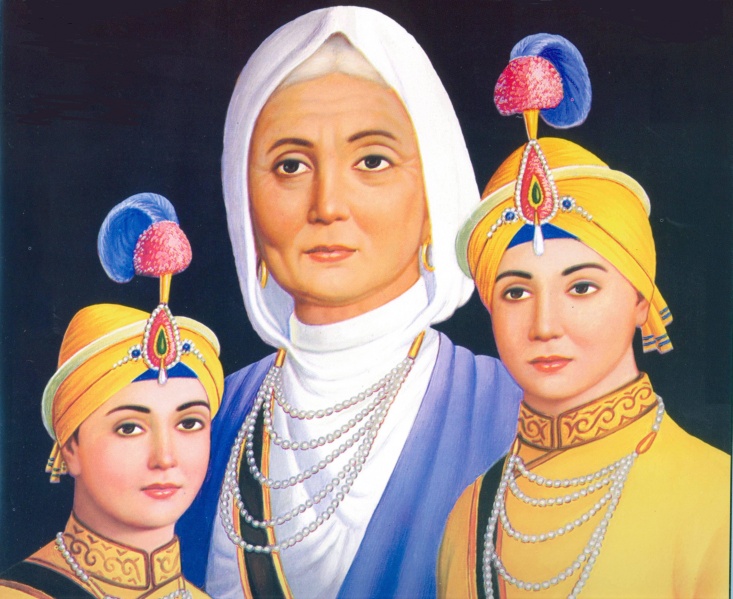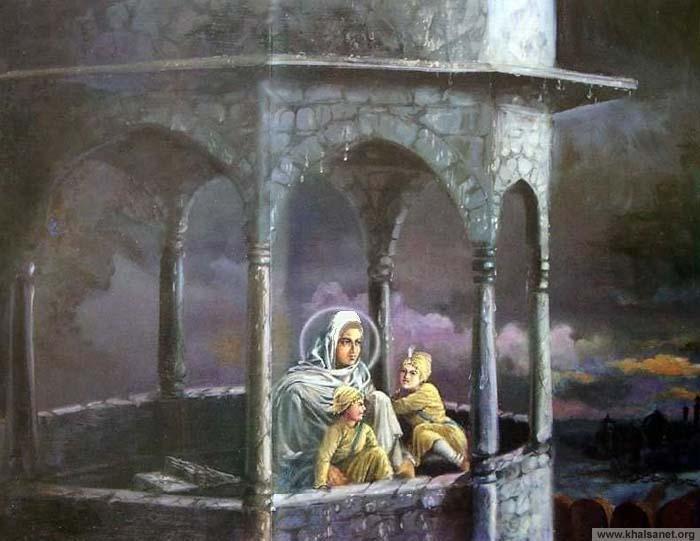Chamakde_Taare-panthkhalsahub.blogspot.com FREE DOWNLOAD
Mata Gujri je
Mata Gujri (1624 -1705) (whose formal name was 'Mata Gujar Kaur') was the wife of the ninth Sikh Guru, Guru Tegh Bahadur; the mother of the tenth and last human Sikh Guru,Guru Gobind Singh and the grandmother of the four Sahibzade.
She was born in 1624 and was the daughter of Bhai Lal Chand Subulikka and Bishan Kaur, a pious couple of Kartarpur, in present-day Kapurthala district of the Punjab. Her role in the development of the Sikh faith has been crucial.
She was the wife of a supreme martyr; mother of a brave saint-soldier; and the grand-mother of four amazing children who all attained martyrdom at the ages of 6, 9, 14 and 18 years. She had been close to the two younger sahibzade and took up their guardianship in the flight from Anandpur under a promise of safe passage to Punjab. Imprisoned in the Thanda Burj of Sirhind with her youngest grandsons Zorawar and Fateh Singh, she attained martyrdom, at the age of 81 years, when she was told of their execution.
Mata Gujri je as a grandmother
Mata ji received Amrit during the Vaisakhi Amrit Sanchar along with the rest of the family and was renamed 'Gujar Kaur'. When in face of a prolonged siege by hostile hill rajas and Mughal troops, Chakk Nanaki (Anandpur Sahib) had to be evacuated by Guru Gobind Singh on the night of 5-6 December 1705, Mata Gujar Kaur with her younger grandsons, Sahibzada Zorawar Singh and Fateh Singh, aged nine and seven year respectively, were separated from the main body while crossing the swollen rivulet Sarsa. The three of them were led by their servant, Gangu, to the latter's village, Saheri, near Morinda in present day Ropar district, where he treacherously betrayed them to the local Muslim officer.
Mata Gujar Kaur and her grandsons were arrested on 8 December 1705 and confined in Sirhind Fort in what is referred to in Sikh chronicles as Thanda Burj, the cold tower. As the children were summoned to appear in court from day to day, the grandmother kept urging them to remain steadfast in their faith. On 11 December they were ordered to be bricked up alive in a wall, but, since the masonry crumbled before it covered their heads, they were executed the following day. Mata Gujar Kaur ji was imprisoned on top of a tower which was opened from all sides without any warm clothes in very cold month of December. She continued the tradition of Sikhi and without complaints give her body singing guru ki Bani. Mata Gujar Kaur ji attained martyrdom the same day as her grandsons.
No doubt Guru Nanak Dev ji had said "Why isn't woman equal to man when she is who gave birth to kings, and protectors of Dharma". Mata Gujar Kaur ji through upbringing of her grandsons played such an important role in Sikhi that as Sikhs, we can owe our existence to her. It was due to her teachings that 6 year old and 9 year old did not bulge from their Dharma and attained martyrdom. Thus continuing and emphasizing the institute of martyrdom in Sikhism. Seth Todar Mall, a kindhearted wealthy man of Sirhind, cremated the three dead bodies the next day.
At Fatehgarh Sahib, near Sirhind, there is a shrine called Gurdwara Mata Gujari (Thanda Burj). This is where Mata Gujar Kaur ji spent the last four days of her life. About one kilometer to the southeast of it is Gurdwara Joti Sarup, marking the cremation site. Here, on the ground floor, a small domed pavilion in white marble is dedicated to Mata Gujar Kaur. The Sikhs from far and near come to pay homage to her memory, especially during a three-day fair held from 1113 Poh, Bikrami dates falling in the last week of December
www.sikhiwiki.org


No comments:
Post a Comment